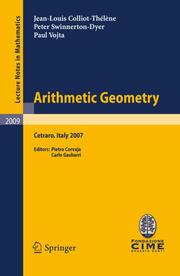Detailansicht
Arithmetic Geometry
Lectures given at the C.I.M.E.Summer School held in Cetraro, Italy, September 10-15,2007 - Lecture Notes in Mathematics/Fondazione C.I.M.E., Firenze 2009, Engl/frz, Lecture Notes in Mathematics 2009 - C.I.M.E. Foundation Subseries
ISBN/EAN: 9783642159442
Umbreit-Nr.: 1342089
Sprache:
Englisch
Umfang: xi, 232 S.
Format in cm:
Einband:
kartoniertes Buch
Erschienen am 04.11.2010
Auflage: 1/2010
- Zusatztext
- Arithmetic Geometry can be defined as the part of Algebraic Geometry connected with the study of algebraic varieties through arbitrary rings, in particular through non-algebraically closed fields. It lies at the intersection between classical algebraic geometry and number theory. A C.I.M.E. Summer School devoted to arithmetic geometry was held in Cetraro, Italy in September 2007, and presented some of the most interesting new developments in arithmetic geometry. This book collects the lecture notes which were written up by the speakers. The main topics concern diophantine equations, local-global principles, diophantine approximation and its relations to Nevanlinna theory, and rationally connected varieties. The book is divided into three parts, corresponding to the courses given by J-L Colliot-Thelene, Peter Swinnerton Dyer and Paul Vojta.
- Kurztext
- Arithmetic Geometry can be defined as the part of Algebraic Geometry connected with the study of algebraic varieties over arbitrary rings, in particular over non-algebraically closed fields. It lies at the intersection between classical algebraic geometry and number theory. A C.I.M.E. Summer School devoted to arithmetic geometry was held in Cetraro, Italy in September 2007, and presented some of the most interesting new developments in arithmetic geometry. This book collects the lecture notes which were written up by the speakers. The main topics concern diophantine equations, local-global principles, diophantine approximation and its relations to Nevanlinna theory, and rationally connected varieties. The book is divided into three parts, corresponding to the courses given by J-L Colliot-Thélène Peter Swinnerton Dyer and Paul Vojta.
